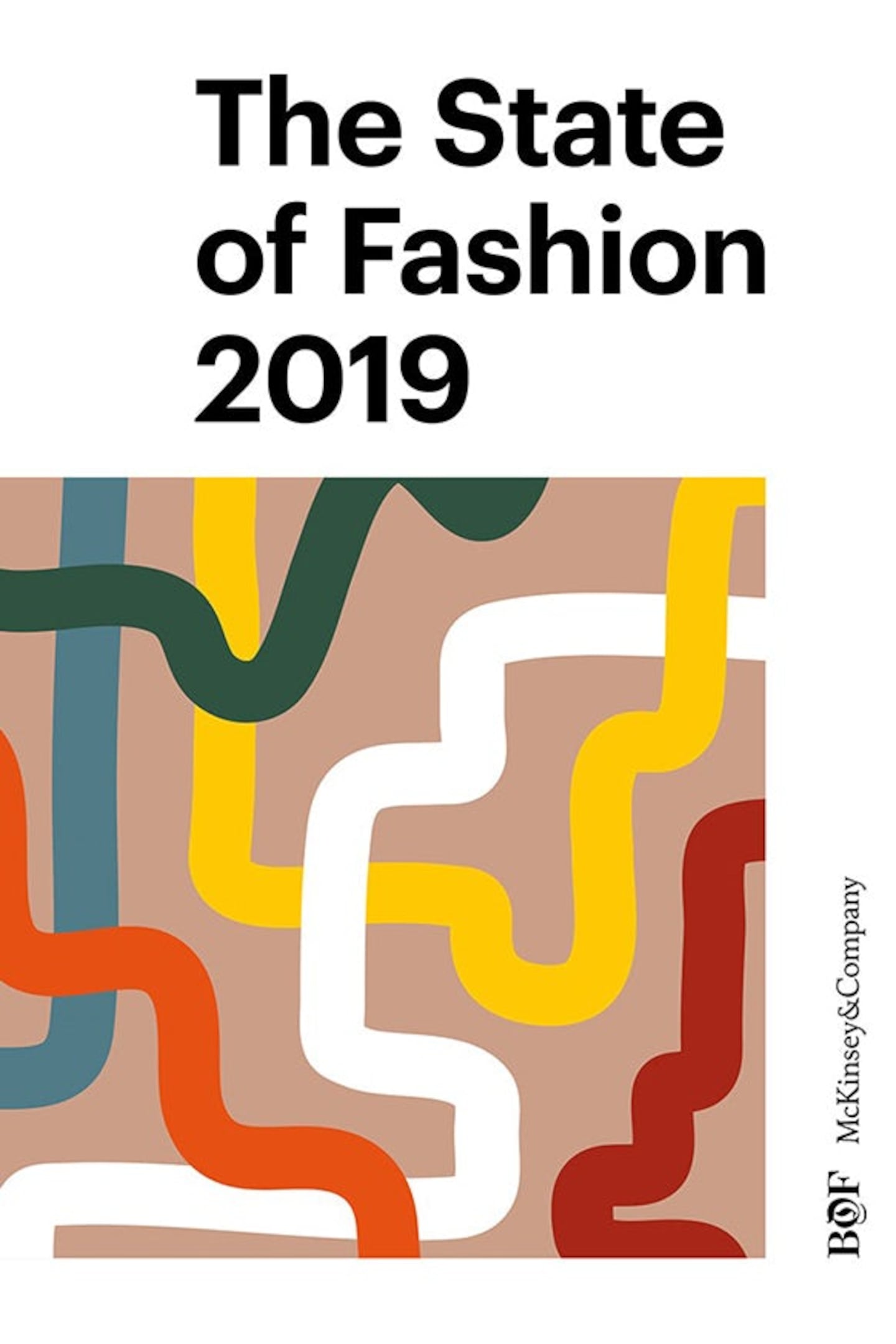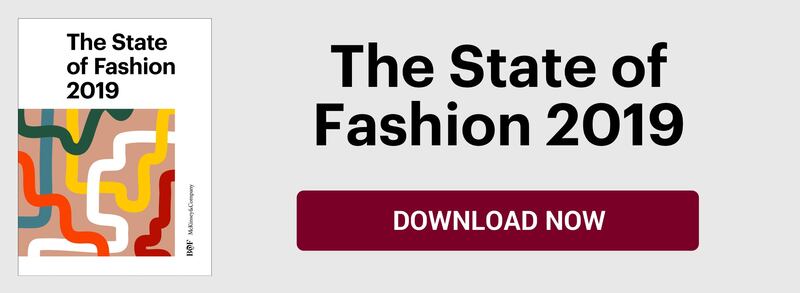
The Business of Fashion
Agenda-setting intelligence, analysis and advice for the global fashion community.

Agenda-setting intelligence, analysis and advice for the global fashion community.

 Opens in new window
Opens in new windowThe Business of Fashion and McKinsey & Company have now released The State of Fashion 2021, focusing on the themes, issues and opportunities impacting the sector. Download fashion’s most authoritative report here.
LONDON, United Kingdom — 2019 will be a year of awakening for the fashion industry, one that will go down in history, finds The State of Fashion 2019, a new report co-published by The Business of Fashion (BoF) and McKinsey & Company that was released today. According to McKinsey Fashionscope, Greater China will for the first time in centuries overtake the US as the world’s largest fashion market, while external shocks to the system continue to lurk around the corner. Industry growth is therefore expected to slow to 3.5 to 4.5 percent, slightly below 2018 figures.
The majority of executives across different segments and geographies remain pessimistic, citing “dealing with volatility, uncertainty and shifts in the global economy” as their primary concerns for the year ahead. Risks of trade disruptions and slowing economic growth, even in key growth markets in Asia, could undermine global market growth prospects, as could uncertainty over other major events, such as the Brexit or the possible onset of a global economic slowdown.
“Optimism can be found in pockets, notably in North America and in the luxury segment, aided by their strong performance in 2018,” says Imran Amed, founder and editor-in-chief of BoF. “But they cannot rest on their laurels as the market continues to be characterised by radical shifts in the global economy, consumer behaviour and the fashion system itself.”
ADVERTISEMENT
“Looking at segments, only value and luxury will perform very well in 2019, growing by 5.0 to 6.0 and to 5.5 percent. Value will be primarily driven by competitors having very strong propositions that edge out the mid-market players. Luxury, on the other hand, will be fuelled by fast-growing Asia-Pacific economies and the continuing boom in global travel,” says Achim Berg, senior partner and expert on the fashion and luxury industry at McKinsey & Company.
The report recognises the rise of “super winners,” the top 20 publicly listed companies that are increasingly dominating the industry in terms of value creation. This group includes brands such as Nike, LVMH and Inditex, and it now accounts for around $25 billion of economic profit, which is 97 percent of total industry value created, compared to 70 percent in 2010. Over time, North American department stores have lost traction amongst this cohort, with none remaining in the top 20, compared to three 10 years ago. Also of note, online retailers have yet to break into this elite group with none represented in the top 20 at all.
The State of Fashion 2019 also includes the third read-out of our industry benchmark, the McKinsey Global Fashion Index (MGFI). Its database of over 500 private and public companies allows us to analyse and compare the performance of individual companies against their peers by category, segment or region. Now three years in, this is an unrivalled resource on which we continue to build.
Fashion players cannot rest on their laurels as the market continues to be characterised by radical shifts in the global economy, consumer behaviour and the fashion system itself.
The year ahead is one that will go down in history. Greater China will for the first time in centuries overtake the US as the world’s largest fashion market. It will be a year of awakening after the reckoning of 2018 — a time for looking at opportunities, not just challenges. In the US and in the luxury sector it will be a year of optimism; for Europe and for struggling segments such as the mid-market, optimism may be in short supply. Far-sighted companies will make bold moves in automation and AI, and will disrupt themselves before others do it for them. Consumers will make or break brands based on trust. And global economic and political trends hover over the whole picture.
In short, it’s going to be a bumpy ride. But whatever your role — from boardroom executive to start-up founder to informed consumer — The State of Fashion 2019 report will cushion the impact and tell you everything you need to know about the state of fashion in the year to come.
The 10 trends that will set the agenda for the global fashion industry in 2019
1. Caution Ahead
Downward movements in key economic indicators and other potentially destabilising forces will conspire to create a more cautious mood. With the possibility of a global economic slowdown by 2020, companies will turn more prudent and start to look more aggressively into opportunities to boost productivity compared to previous years.
ADVERTISEMENT
2. Indian Ascent
India becomes a focal point for the fashion industry as its middle-class consumer base grows and manufacturing sector strengthens. Fashion players must redouble their efforts in this highly fragmented and challenging market where an educated and tech-savvy demographic rub shoulders with the poor and upwardly mobile.
3. Trade 2.0
All companies will need to prepare contingency plans to face a potential shake-up of global value chains. On the one hand, the apparel trade could be reshaped by new barriers, trade tensions and uncertainty and, on the other hand, by new opportunities from growing South-South trade and the renegotiation of trade agreements.
4. The End of Ownership
The lifespan of the fashion product is becoming more elastic as pre-owned, refurbished, repair and rental business models continue to evolve. Fashion players will increasingly tap into this market to gain access to new consumers seeking both affordability and a move away from the permanent ownership of clothing.
5. Getting Woke
Younger generations’ passion for social and environmental causes has reached critical mass, causing brands to become more fundamentally purpose-driven to attract both consumers and talent. Consumers from some but not all markets will reward players that take a strong stance on social and environmental issues beyond traditional CSR.
ADVERTISEMENT
6. Now or Never
In the mobile consumer journey, the gap between discovery and purchase has become a pain-point for a more impatient fashion consumer, who seeks to purchase exactly the products they discover, immediately. Players will focus on bridging this gap through shorter lead times, improved availability of advertised products and new technologies such as visual search.
7. Radical Transparency
After years of having personal data owned and handled by businesses, a more distrusting consumer now expects companies to reciprocate with radical transparency and sharing of information. For companies to meet a new bar for consumer trust, they will need to offer a heightened level of transparency along dimensions such as value for money, creative integrity and data protection.
8. Self-Disrupt
Traditional brands are beginning to disrupt their own business models, image and offering in response to a new breed of small emerging brands that are accelerating thanks to decreasing brand loyalty and a growing appetite for newness. We expect more brands to follow suit on this path of self-disruption, which will have a significant impact on their operating models.
9. Digital Landgrab
As the race to be the platform of choice for both customers and brands intensifies, e-commerce players will continue to innovate by adding profitable value-added services. Whether through acquisitions, investments or internal R&D, those players who diversify their ecosystem will strengthen their lead over those who remain pure players relying solely on retail margins.
10. On Demand
Automation and data analytics have enabled a new breed of start-ups to achieve agile made-to-order production. Mass players will begin to experiment next, responding more rapidly to trends and consumer demands, achieving just-in-time production and reducing overstock and making short, small-batch production cycles the new norm.
 Opens in new window
Opens in new windowThe Swiss watch sector’s slide appears to be more pronounced than the wider luxury slowdown, but industry insiders and analysts urge perspective.
The LVMH-linked firm is betting its $545 million stake in the Italian shoemaker will yield the double-digit returns private equity typically seeks.
The Coach owner’s results will provide another opportunity to stick up for its acquisition of rival Capri. And the Met Gala will do its best to ignore the TikTok ban and labour strife at Conde Nast.
The former CFDA president sat down with BoF founder and editor-in-chief Imran Amed to discuss his remarkable life and career and how big business has changed the fashion industry.